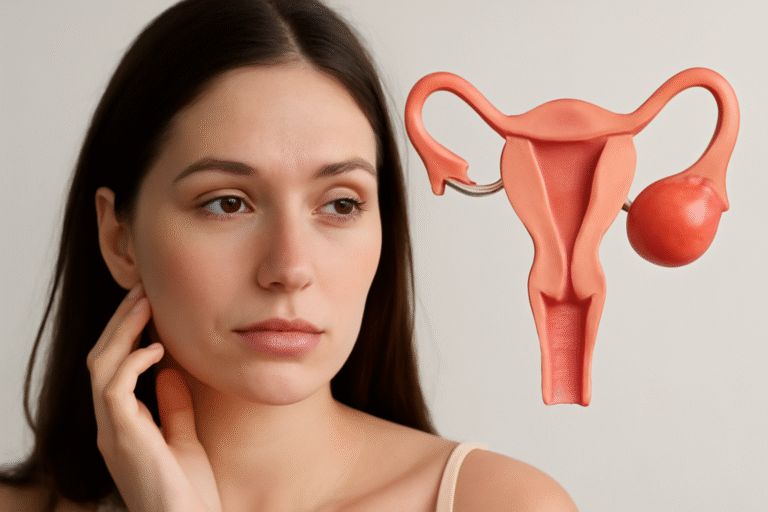Introduction: The Symphony of Female Hormones
Governed by a fragile hormone balance, a woman’s body is a marvel of biological engineering. From mood and energy levels to conception and pregnancy, these chemical messengers govern all. When it comes to menstruation and pregnancy, however, two hormones stand out as the main regulators: estrogen and progesterone.
Every woman has to know these hormones, whether she is tracking her menstrual cycle, intending a pregnancy, or just trying to regulate her health. This comprehensive manual will investigate the following
The role of estrogen and progesterone in menstruation
How they support pregnancy
What happens when these hormones are imbalanced
Tips for maintaining hormonal health
Estrogen: The Master Regulator of the Female Body
The main female sex hormone, estrogen, is mostly generated in the ovaries; tiny quantities are also produced in adipose tissues and the adrenal glands. The three key categories are:
- Estrone (E1) Dominant post-menopause
- Estradiol (E2) The most active kind throughout reproductive
- Estriol (E3) Increases with pregnancy.
Key Functions of Estrogen
- Regulates the Menstrual Cycle
- Prepares the endometrium, or uterine lining, for possible pregnancy by stimulating its development.
- Causes an egg to be released during ovulation.
- Supports Pregnancy
- Helps embryo implantation by thickening the uterine lining.
- Increases uterine blood flow for fetal feeding.
- Maintains Bone & Heart Health
- Preserves bone density, hence lowering the likelihood of osteoporosis.
- Maintains good cholesterol levels to safeguard heart health.
- Affects Mood & Libido
- Changes might bring about PMS symptoms like bloating and irritability.
- Higher levels increase sexual desire, particularly during ovulation.
Did you happen to know? The early part of the menstrual cycle (the follicular phase) has the greatest estrogen levels, which peak immediately before ovulation.
Also Read: Identify Your Fertility Days
Progesterone: The Guardian of Pregnancy
Often called the “pregnancy hormone”, progesterone is essential for sustaining a healthy gestation. It’s produced by:
- The ovaries (after ovulation)
- The placenta (during pregnancy)
- The adrenal glands (in modest quantities)
Key Functions of Progesterone
- Prepares the Uterus for Pregnancy
- Progesterone thickens the uterine lining after ovulation to assist a fertilized egg.
- Should pregnancy take place, it stops the endometrial shedding (no period).
- Supports Early Pregnancy
- Keeps the uterine environment going until the placenta controls it.
- Stops uterine contractions that can cause early labor.
- Balances Estrogen
- Prevents problems, including estrogen dominance—related to fibroids, heavy periods, and mood swings—by offsetting estrogen’s effects.
- Affects Mood & Sleep
- Encourages relaxation (which explains why some women feel drowsy during the luteal phase).
- Low levels might cause sleeplessness and anxiety.
Fun Fact: Progesterone levels rise during ovulation; if pregnancy doesn’t happen, they fall, causing menstruation
How These Hormones Work Together in the Menstrual Cycle
Though cycle durations differ, the menstrual cycle is a 28-day hormonal dance. Estrogen and progesterone interact as follows:
- Follicular Phase (Day 1-14)
- Estrogen increases, encouraging the development of the uterine lining.
- The pituitary gland produces Follicle-Stimulating Hormone (FSH), which helps an egg develop.
- Ovulation (Around Day 14)
- Estrogen rises, stimulating the growth of the uterine lining.
- The pituitary gland releases follicle-stimulating hormone (FSH), helping an egg mature.
- Luteal Phase (Day 15-28)
- The corpus luteum forms from the ruptured follicle, which generates progesterone.
- Progesterone maintains the uterine lining intact should pregnancy.
- Progesterone decreases if there is no pregnancy, which causes menstruation.
Hormones in Pregnancy: A Critical Support System
Hormonal shifts guarantee the fetus flourishes once fertilization occurs:
- hCG (Human Chorionic Gonadotropin)
- The pregnancy hormone was found by home testing.
- Tells the corpus luteum to continue making progesterone.
- Surge of Estrogen & Progesterone
- Estrogen increases uterine blood flow and helps the fetus grow.
- By relaxing uterine muscles, progesterone stops miscarriage.
- Placenta Takes Over (After 10-12 Weeks)
- The placenta keeps the pregnancy going by becoming the primary source of progesterone.
Hormonal Imbalances: Signs & Solutions
Women may suffer when estrogen and progesterone are out of balance:
Common Symptoms of Hormonal Imbalance
- Skipped or erratic cycles
- Painful or heavy periods
- Depression, anxiety, or mood changes
- Gaining weight, particularly around the hips and thighs
- Vaginal dryness or low libido
- Endometriosis or PCOS (Polycystic Ovary Syndrome)
How to Restore Balance Naturally
- Eat a hormone-friendly diet of healthy fats, fiber, and phytoestrogens.
- Yoga and walking assist in controlling hormones; hence, frequent exercise is recommended.
- Control stress (elevated cortisol interferes with progesterone and estrogen).
- Think about supplements; omega-3s, vitamin B6, and magnesium help hormonal health.
Final Thoughts: Honoring Your Hormonal Health
The unsung champions of a woman’s reproductive path are estrogen and progesterone. From the first period to pregnancy and beyond, these hormones influence general vigor, emotions, and fertility.
Did this book assist you? Post your ideas or inquiries here!





[…] Also read: “Key Female Hormones in Menstruation & Pregnancy […]